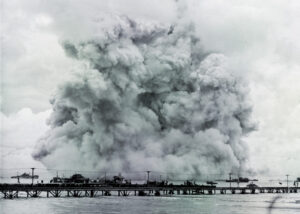The Golden Age Remembered: U.S. Naval Aviation, 1919-1941, edited by E.T. Woolridge, Naval Institute Press, Annapolis, Md., 1998, $36.95.
Today we can cross the Atlantic Ocean in less than four hours. Business travelers routinely fly from one coast to the other and return home in time for dinner. Humans have walked on the moon and are now turning their sights toward exploration of other planets. How easy it is to forget that all this started less than 100 years ago on a wind-swept dune in Kitty Hawk, N.C., with two brothers who had a dream.
Among all the technological advances of the 20th century, the tremendous inroads toward the conquering of time and space are arguably the most phenomenal, and all of those advances are rooted in the advent of air travel. One can only wonder if, in their wildest dreams, Orville and Wilbur envisioned where it would all lead. But the Wright brothers were only two among many others with the same dream. Countless other aviators who came before and after them were pioneers, constantly exploring the mysteries of flight, “pushing the envelope” to go farther, faster, higher. The Golden Age Remembered: U.S. Naval Aviation, 1919-1941 recounts the story of 14 of those pioneers of manned flight in wonderful detail.
Almost from the very beginning, naval aviators played a major role in the history of flight. From Admiral Richard Byrd’s exploratory flights to the breathtaking escapades of Navy pilots in the National Air Races to the major role Navy airmen played in winning the war in the Pacific during World War II, the exploits of airmen dressed in Navy whites were splashed across the front pages of newspapers during much of the first half of the century.
Here, in their own words, 14 of the men who played major roles during those glory years tell us what it was like to be at the forefront of a new age. The reader is escorted through the first classes of Navy pilots, to the conversion of the collier Jupiter into Langley, the Navy’s first aircraft carrier, to that infamous day at Pearl Harbor in December 1941 and everything in between.
When you read these firsthand accounts it is easy to understand where Hollywood came up with its stereotypical image of the “devil-may-care” aviator, sort of a Douglas Fairbanks in leather helmet and goggles. But something else comes through as well, all the more telling for its understatement–the professionalism and the quiet pride these men felt in their accomplishments, as well as their knowledge that much of what we take for granted today is due in no small part to their efforts and achievements.
Too often reviewers must, in fairness to the public, advise that a book should be read only if the reader has a special interest in its particular subject matter. Fortunately this is not one of those books. If you have ever looked up in the sky and dreamed of joining the birds, pick up a copy of The Golden Age Remembered: U.S. Naval Aviation, 1919-1941 and be transported back to an age when every trip skyward was an adventure. You’ll be glad you took the time.
B. Keith Toney




